Classification Of 3D Printing Technologies In Dentistry
- Additive manufacturing is finding increasing use in dentistry.
- More popularly known as ‘threedimensional printing’, it is an additive manufacturing process in contrast to conventional CAD/ CAM which is a subtractive process.
- The first 3D printer was invented by Hideo Kodama of Nagoya, Japan.
- In 1984, Chuck Hull of 3D Systems Corporation further refined the process and named it stereolithography.
- The process involved the sequential laying down of photocured polymer to produce a three-dimensional plastic object.
Read And Learn More: Basic Dental Materials Notes
- As the technology developed it encompassed a wider variety of technologies and materials including metals, waxes, polymers, paper, ceramics, etc.
- By 2000, the umbrella term additive manufacturing (AM) technologies were used to describe all processes involving the CAD-based production of objects through sequential layering.
- Synonyms Other terms include three-dimensional printing, desktop manufacturing, rapid manufacturing, additive fabrication, additive layer manufacturing, layer manufacturing, freeform fabrication, rapid prototyping, etc.
3D Printing Technologies Applications In Dentistry
Using data from oral scans and CAD designs, 3D printing can be used to produce
- Surgical guides.
- Veneers for try-in.
- Study models.
- Orthodontic appliances (aligners).
- Surgical planning and mock surgeries using models designed with the aid of CT or MRI scan data.
- Wax patterns for casting dental restorations like inlays, crowns, and FDPs.
- Restorations and removable denture frames can be directly fabricated from raw metal (Co-Cr, titanium or gold alloy in powder form).
- Maxillofacial prostheses.
- Bioprinting can potentially engineer living organs, bones, skin, and other tissues for plastic and reconstructive surgery, drug testing, etc.
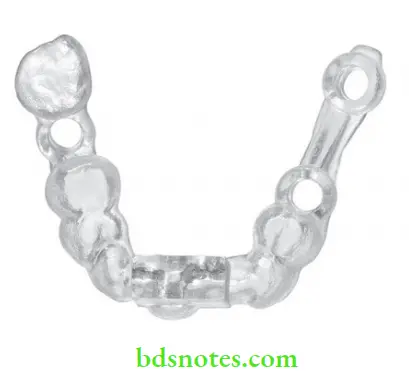
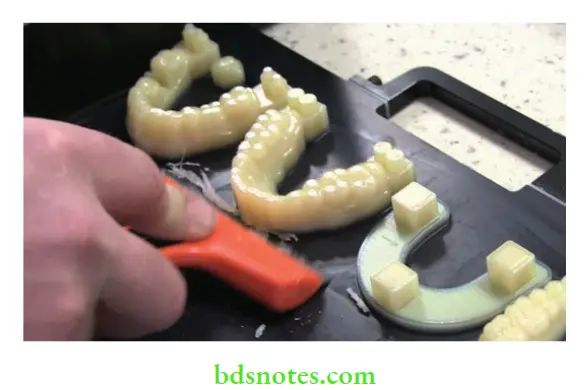
Fundamentals Of 3D Printing In Dentistry
The fundamentals of additive manufacturing include
- Scan data input
- Computer-aided design
- Computer-aided (additive) manufacturing
- 3D printable models may be created with a computer-aided design (CAD) package or via a 3D scan of the mouth, impression or model.
- CT or MRI data can also be used. The computer corrects errors in the scan data called fi-up.
- The 3D model which is in .skp, .dae, .3Ds or some other format needs to be converted to either a .
- STL or a . OBJ format, to allow the printer’s software to be able to read it.
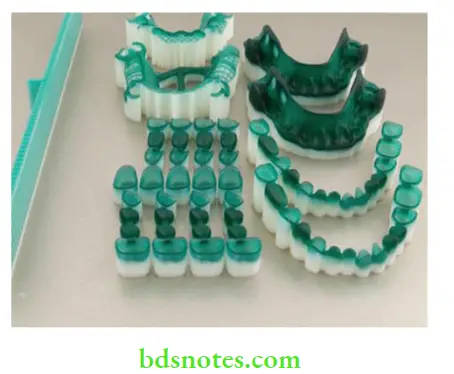
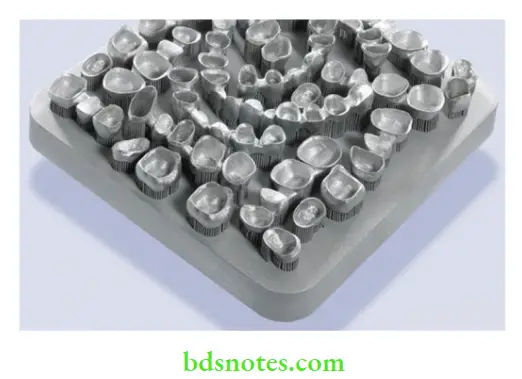
- Once that is done, the.STL file needs to be processed by a piece of software called a “slicer” which converts the model into a series of thin layers and produces a G-code file containing instructions for the specific type of 3D printer used.
- The 3D printer follows the G-code instructions to lay down successive layers of liquid, powder, binder, paper or sheet material to build the model from a series of cross-sections.
Classification Of Additive Manufacturing Technologies
- The different types of 3D printers each employ a different technology that processes different materials in different ways.
- It is important to understand that one of the most basic limitations of 3D printing, in terms of materials and applications is that there is no ‘one solution for all’.
- For example some 3D printers process powdered materials (nylon, plastic, ceramic, metal), which utilize a heat source (laser, electron beam) to sinter/melt/fuse layers of the powder together in the defined shape.
- Others process liquid resin and again utilize a light/laser to solidify the resin layer by layer.
- Jetting of fine droplets is another 3D printing process, reminiscent of 2D inkjet printing, but with a binder to fi the layers.
- Perhaps the most common and easily recognized process is deposition, and this is the process employed by the majority of entry-level 3D printers.
- This process extrudes plastics, commonly PLA or ABS, in filament form through a heated extruder to form layers and create the predetermined shape.
- The various types of additive manufacturing technologies currently available are summarized.
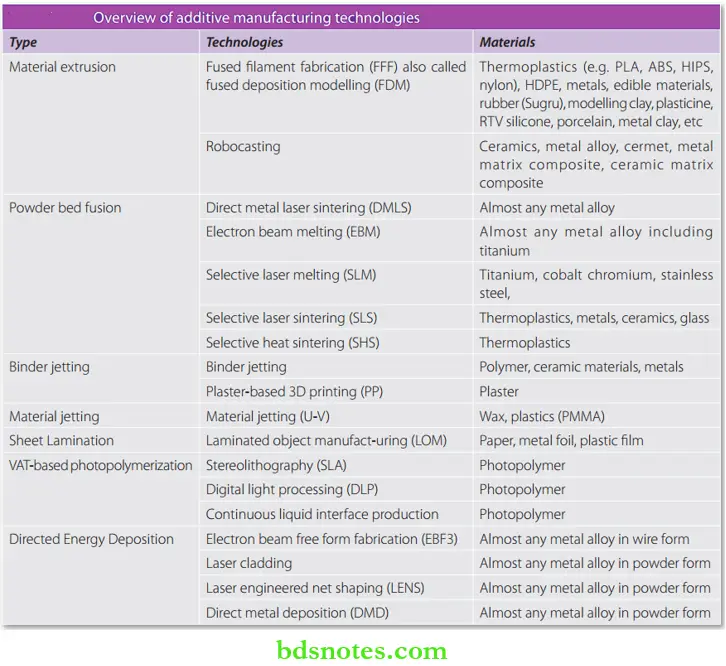
Description Of Some Additive Manufacturing Technologies In Dentistry
Material jetting
- Material jetting is a 3D printing process whereby the actual build materials (in liquid or molten state) are selectively jetted through multiple jet heads (with others simultaneously jetting support materials).
- However, the materials tend to be liquid photopolymers, which are cured with a pass of UV light as each layer is deposited.
- Material jetting is the only additive manufacturing technology that can combine different print materials within the same 3D printed model in the same print job.
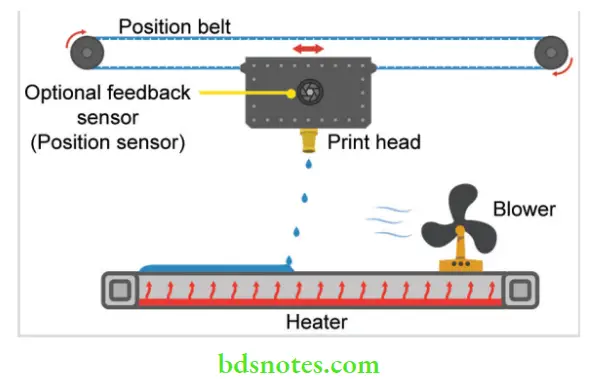
Binder jetting
- In binder jetting, the material being jetted is a binder. It is selectively sprayed into a powder bed to fuse it a layer at a time to create the required part.
- As is the case with other powder bed systems, once a layer is completed, the powder bed drops incrementally and a roller or blade smooths the powder over the surface of the bed, prior to the next pass of the jet heads.
- Advantages of this process like with SLS, include the fact that the need for support is negated because the powder bed itself provides this functionality.
- Furthermore, a range of different materials can be used, including ceramics and food.
- A further distinctive advantage of the process is the ability to easily add a full-color palette which can be added to the binder.
- The parts resulting directly from the machine, however, are not strong and may require post-processing to ensure durability.
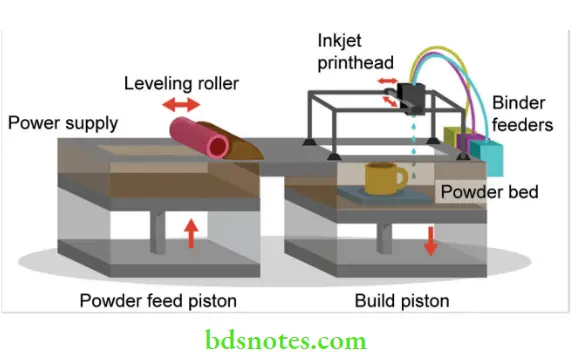
Digital light processing (DLP)
- DLP or digital light processing is a similar process to stereolithography in that it is a 3D printing process that works with photopolymers.
- The major difference is the light source. DLP uses a more conventional light source, such as an arc lamp, with a liquid crystal display panel or a deformable mirror device, which is applied to the entire surface of the of photopolymer resin in a single pass, generally making it faster than SL.
- However, one advantage of DLP over SL is that only a shallow vat of resin is required to facilitate the process, which generally results in less waste and lower running costs.
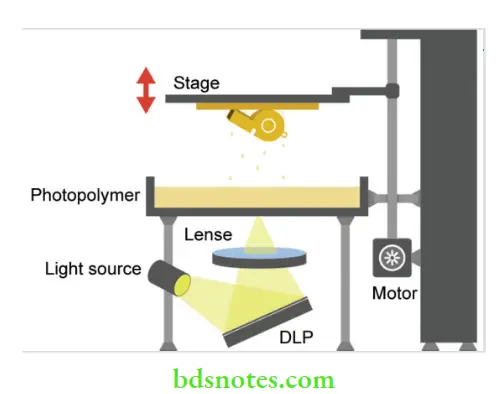
Fused deposition modeling
- 3D printing utilizing the extrusion of thermoplastic material is probably the most common and recognizable 3D printing process.
- The popular name for the process is fused deposition modeling (FDM), however, this is a trading name, registered by Stratasys, the company that originally developed it.
- Other manufacturers generally referred to it as Fused Filament Fabrication (FFF).
- The process works by melting plastic filament that is deposited, via a heated extruder, a layer at a time, onto a build platform.
- Each layer hardens as it is deposited and bonds to the previous layer. Systems have evolved and improved to incorporate dual extrusion heads.
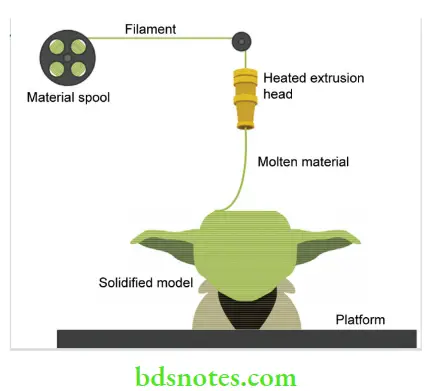
Robocasting
- Robocasting or Direct Ink Writing (DIW) is an additive manufacturing technique in which a filament of ‘ink’ is extruded from a nozzle, forming an object layer by layer.
- The technique was first developed in the United States in 1996 as a method to allow geometrically complex ceramic green bodies to be produced.
- A fluid (typically a ceramic slurry), referred to as an ‘ink’, is extruded through a small nozzle, drawing out the shape of each layer of the CAD model.
- The ink exits the nozzle in a liquid-like state but retains its shape immediately, exploiting the rheological property of shear thinning.
- It is distinct from fused deposition modeling (FDM) as it does not rely on solidification or drying to retain its shape after extrusion.
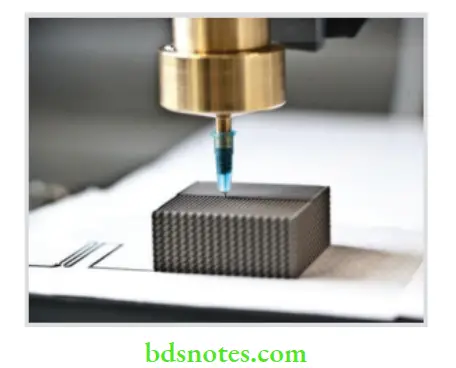
- To date, the most researched application for robocasting is in the production of biologically compatible tissue implants (bioprinting).
- Lattice structures can be formed quite easily which allows bone and other tissues in the human body to grow and eventually replace the transplant.
- With various medical scanning techniques, the precise shape of the missing tissue is established and input into 3D modeling software and printed.
Electron beam melting (EBM)
- The Electron Beam Melting 3D printing technique is a proprietary process developed by the Swedish company Arcam.
- This metal printing method is very similar to the Direct Metal Laser Sintering (DMLS) process in terms of the formation of parts from metal powder.
- The key difference is the heat source, which, as the name suggests is an electron beam, rather than a laser, which necessitates that the procedure is carried out under vacuum conditions.
- EBM has the capability of creating fully-dense parts in a variety of metal alloys, even to medical grade, and as a result, the technique has been particularly successful for a range of production applications in the medical industry, particularly for implants.
- However, other hi-tech sectors, such as aerospace and automotive have also looked to EBM technology for manufacturing fulfillment.
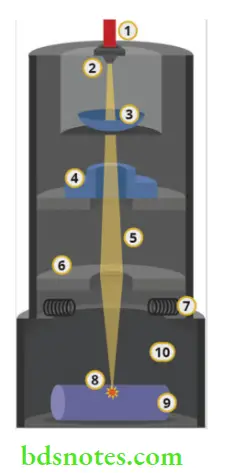
- High voltage cable
- Incandescent cathode
- Bias cup
- Primary anode
- Electron beam
- Focusing coil
- Deflection coil
- Weld bead
- Workpiece
- Vacuum chamber
Laser sintering technique
- Laser sintering and laser melting are interchangeable terms that refer to a laser-based 3D printing process that works with powdered materials.
- The laser is traced across a powder bed of tightly compacted powdered material.
- As the laser interacts with the surface of the powdered material it sinters, or fuses, the particles to each other forming a solid.
- As each layer is completed the powder bed drops incrementally and a roller smooths the powder over the surface of the bed prior to the next pass of the laser for the subsequent layer to be formed and fused with the previous layer.
- The build chamber is completely sealed as it is necessary to maintain a precise temperature during the process.
- Once finished, the excess powder is removed to leave the ‘printed’ parts. One of the key advantages of this process is that the powder bed serves as an in-process support structure for overhangs and undercuts, and therefore complex shapes that could not be manufactured in any other way are possible with this process.
- However, on the downside, because of the high temperatures required for laser sintering, cooling times can be considerable.
- Furthermore, porosity has been an issue with this process, and while there have been significant improvements toward fully dense parts, some applications still necessitate infiltration with another material to improve mechanical characteristics.
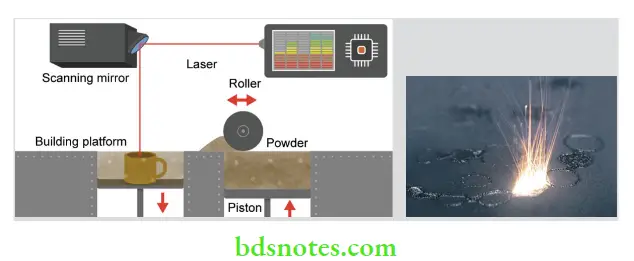
Sheet lamination and Directed energy deposition
Sheet lamination
- Sheet lamination processes include ultrasonic additive manufacturing (UAM) and laminated object manufacturing (LOM).
- The Ultrasonic Additive Manufacturing process uses sheets or ribbons of metal, which are bound together using ultrasonic welding.
Directed energy Deposition
- Directed energy deposition (DED) covers a range of terminology like laser engineered net shaping, directed light fabrication, direct metal deposition, 3D laser cladding’ It is a more complex printing process commonly used to repair or add additional material to existing components.
- In this class of technology metal or alloy powder is actually deposited on the work surface and sintered or melted using various means.
3D DentAl Printers In Dentistry
- 3D printers for dental applications are manufactured by a range of companies.
- These include Invision wax printer, Objet Eden 260V, Varseo Dental 3D Printing System (BEGO), Projet 3510DPPro, 3Z LAB 3D wax printer (solid scape), Stratasys Crownworx and Frameworx, Renishaw AM 250 (for metal), etc.
- They range in size from small desktop models to larger floor machines.
- The technology they employ also varies according to the objects they fabricate.

- (A) A 3D wax printer (FrameWorx by Stratasys).
- (B) A 3D printer for dental models and casts.
- (C) A 3D metal printer dental for alloys.
- (D) The Bego (Varseo) uses LED-based stereolithography technology to make RPD and other patterns for casting
Support Structures For 3D Printed Objects In Dentistry
Some printing techniques require external or internal supports to be built for undercut areas, cantilevers, and other overhanging features for greater stability and strength during the manufacturing process. These supports are later mechanically removed or dissolved upon completion of the print.
- In metal and plastic printing, multiple supports are printed connecting the restoration to the base.
- Some 3D printers print wax patterns along with a second water-soluble support material. This material is removed after completion by dissolving in water.
- In powder bed systems, the unused powder surrounding the object functions as a support structure
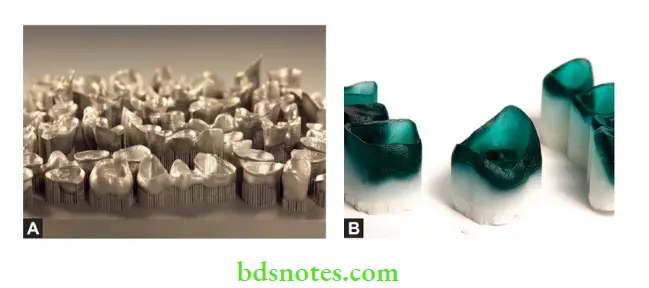
- (A) 3D printed metal crowns and FDPs showing support structures.
- (B) 3D printed wax crowns showing support structures.
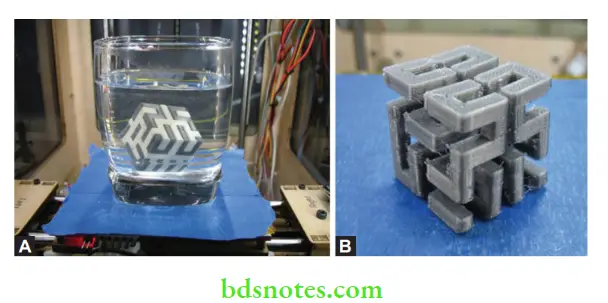
Raw Materials For 3D Printing In Dentistry
- A wide variety of materials are available for 3D printing.
- These include thermoplastics, granulated alloys (titanium alloys, metal alloys), foil, paper, photopolymers, liquid resins, rubber-like materials, silicones, glass, ceramic slurry, foods, medication, bio-ink made of cells and stem cells for tissue generation. etc.
- These materials are in various forms like thermoplastic filaments, wire, granules, powder, photopolymerizing liquid resin, paste, liquid, etc.
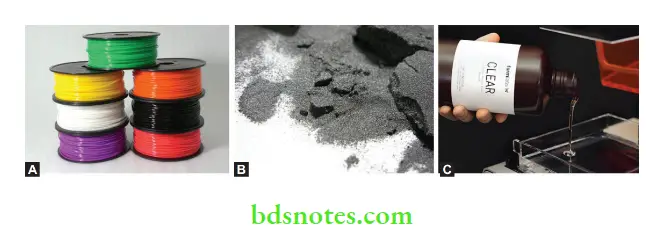
- (A) Thermoplastic filaments for FFD.
- (B) Metal granules for laser sintering.
- (C) Photopolymerizing liquid resin for stereolithography.
Post-Manufacturing Processing
- Following the fabrication, the objects produced may require some form of processing for improved properties and fit.
- Objects manufactured may have layer lines and other artifacts of the printing process.
- Some of the products are produced in the green state and require to be sintered.
- Metals may require various forms of heat treatment.
- Thus post-manufacturing processing includes support material removal, finishing, and polishing, sealing, chemical treatment, sintering, heat treatment, etc.
3D Printed Maxillofacial Prostheses
- British company Fripp Design and Research has developed 3D-printed prosthetic eyes that could be produced much faster than existing handmade versions, reducing the cost by 97 percent.
- The company which is also working on 3D-printed ears and noses for patients with facial disfigurements, has collaborated with Manchester Metropolitan University to develop ocular prosthetics that are 3D-printed in batches, with intricate colored details including the iris and blood vessels already included.
- Currently, prosthetic eyes are molded in acrylic and painted by hand to match the patient’s eye color.
- This process is time-consuming and expensive, whereas producing the eyes using a 3D printer enables up to 150 eyes to be made in an hour.
- All of the components are printed from powder in full color using a Z-Corp 510 machine before the resulting form is encased in resin.
- Compared to the existing handmade production method, this helps to remove any variation in quality and significantly reduces the cost of each eye. (Refer also a chapter on maxillofacial prosthetic materials).
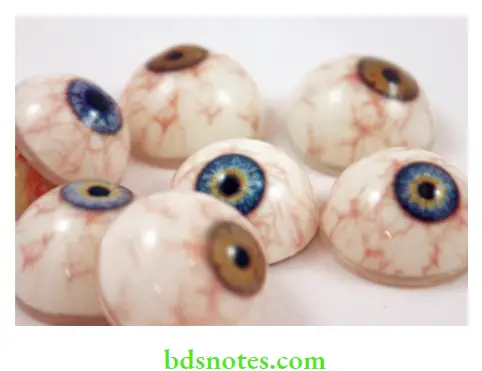
3D Printing Technology In Surgical Planning
- Hospitals around the world are increasingly turning to 3D technology to plan complex surgeries.
- In January 2015, doctors at London’s St Thomas’ Hospital used images obtained from a magnetic resonance imaging (MRI) scan to create a 3D printing replica of the heart of a two-year-old girl with a complex hole in it.
- They were then able to tailor a GoreTex patch to effct a cure. 3D printing means surgeons can go into an operation with a much better idea of what they would find.
- Similarly, plastic and maxillofacial surgeons in Bengaluru, Karnataka, India, used a 3D printed model for a surgical procedure to plan and correct orbital hypertelorism using both a box osteotomy as well as a facial bipartition technique with the aid of Osteo 3D, a company that is focused on 3D printing for the healthcare industry.
- Similar processes are now being used in hospitals and universities to plan complex surgeries, for patient education, and as teaching aids for medical students.
Tissue Engineering
- Several terms have been used to refer to this field of research including organ printing, bioprinting, computer-aided tissue engineering, etc.
- The term regenerative medicine is often used synonymously with tissue engineering, although those involved in regenerative medicine place more emphasis on the use of stem cells or progenitor cells to produce tissues.
- San Diego-based Organovo, a regenerative medicine company, was the first company to commercialize 3D bioprinting technology.
- The company utilizes its NovoGen MMX Bioprinter for 3D bioprinting.
- The printer is optimized to be able to print skin tissue, cartilage, heart tissue, and blood vessels among other basic tissues that could be suitable for surgical therapy and transplantation.
- It is hoped bioprinting technology will eventually be used to create fully functional human organs for transplants.
- They could be used in drug research and perhaps eliminate the need for testing in animals.
- The possibility of using 3D tissue printing to create soft tissue architectures for reconstructive and plastic surgery is also being explored.
- Though scientists have been able to engineer artificial organs such as livers and kidneys, these organs lack crucial elements required for full and independent functioning, such as working blood vessels, tubules for collecting urine, etc.
- Without these, the body has no way to get the essential nutrients and oxygen deep within the tissues. Fully functional printed organs may yet be a possibility in the future.

How Bioprinting Works
- In the bioprinting process, layers of living cells are deposited onto a gel medium or sugar matrix and slowly built up to form three-dimensional structures or scaffolds including vascular systems
- . Another process uses an extracellular matrix (ECM) protein as a scaffold.
- As Organovo has demonstrated, it is not necessary to print all of the details of an organ with a bioprinter, as once the relevant cells are placed in roughly the right place nature completes the job.
- This point is illustrated by the fact that the cells contained in a bio-ink spheroid are capable of rearranging themselves after printing.
- For example, experimental blood vessels printed using bio-ink spheroids comprising of an aggregate mix of endothelial, smooth muscle, and fibroblast cells, once placed in position by the print head demonstrated migration and reorganization.
- With no technological intervention, the endothelial cells migrate to the inside of the printed blood vessel, the smooth muscle cells move to the middle, and the fibroblasts migrate to the outside.
Incubating The New Tissue
- Scientists hope to be able one day to print some types of replacement parts directly into patients’ bodies.
- Currently, tissues must spend a few days to a few weeks maturing in a type of incubator called a bioreactor.
Bioink
- BioInk is a chemically defined hydrogel used to print 3D tissue models in bioprinters.
- It supports the growth of different cell types. It allows cell adhesion, migration, and differentiation.
- It mimics the natural extracellular matrix and is biodegradable.
- This material was developed by researchers at the University of Missouri, Columbia.
- To make bio-ink, scientists create a slurry of cells that can be loaded into a cartridge and inserted into a specially designed printer, along with another cartridge containing a gel known as paper.
- After inputting the standards for the tissue, the printer lays down alternate layers to build a three-dimensional structure, with the paper creating a supportive matrix that the ink can thrive on.

- The individual droplets fuse together, eventually latticing upwards through the paper to create a solid structure.
- One potential use for bio ink is in skin grafting. Creating grafts derived from the patient’s own cells, it could reduce the risk of rejection and scarring.
- Although initial bio ink developments began with skin regeneration, the technology has advanced to also incorporate bone and muscle.
- This makes bio inks a total regenerative technology. Bioink could also be used to make replacements for vascular material removed during surgeries, allowing people to receive new veins and arteries.
- Eventually, entire organs could be constructed from this material. Bioprinted tissue could potentially remove the anxiety of finding donors as well as also allay fears about contaminated organ supplies or unscrupulous organ acquisition methods.
- These will enable medical researchers to test drugs on printed models of the liver and other organs, thereby reducing the need for animal tests.
How bioprinting works
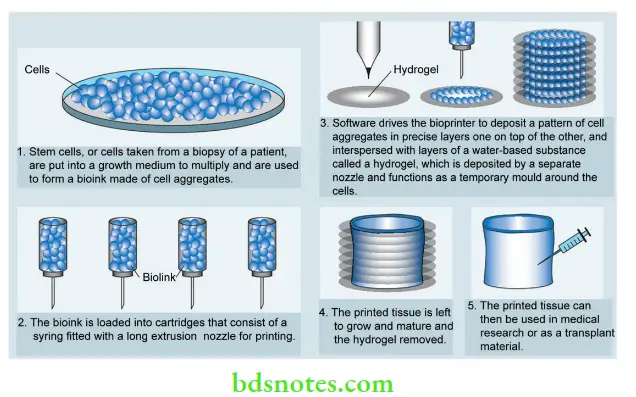
Osteoink
- Osteoink is a ready-to-use calcium phosphate paste for structural engineering dedicated to regenHU’s BioFactory and 3D Discovery printers.
- Osteoink is a highly osteoconductive biomaterial close to the chemical composition of human bone.
- Dedicated for hard tissue engineering, such as bone, cartilage or structural scaffold manufacturing, Osteoink can be combined with regenHU’s biomaterial product portfolio (for example BioInk) to create complex 3D tissue mimetic models.
Comparison Of Additive And Subtractive Manufacturing
- As dental laboratories become increasingly automated, the dental profession has to keep pace with the fast-moving technology.
- Understanding these emerging technologies is the key to making choices on what is best suited for the individual dentist or laboratory professional.
- A comparison of the two CAD-based manufacturing techniques is presented in.

Advantages Of 3D Printing
- Reduction in fabrication times.
- Reduced fabrication costs.
- Clean, safe, and efficient process.
- Less waste as only the required amount of material is used (unlike CAD milling).
- No need to store bulky models as they can be stored digitally and reproduced on demand.
- Hollow objects can be created with greater ease.
- Possible to print complex shapes and structures.
- Possibility of using multiple materials in a single object.
- Less stresses are introduced in the object (compared to machining which may introduce microcracks in the object).
- Rapid prototyping.

Leave a Reply